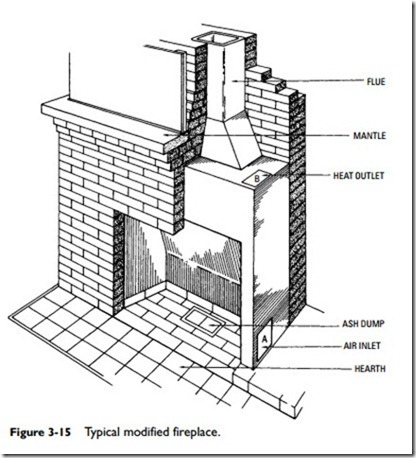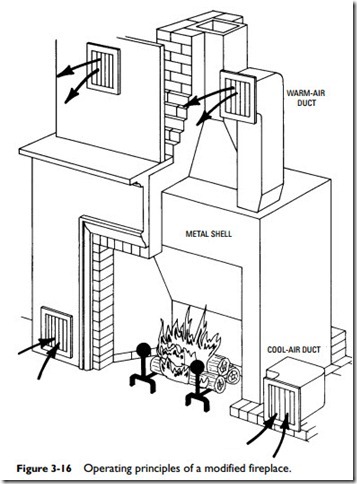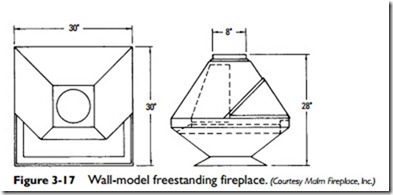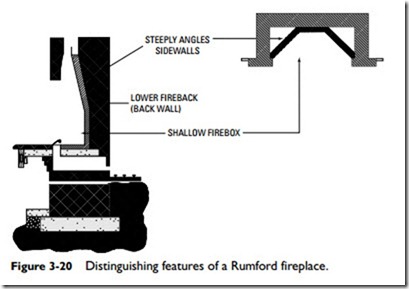Freestanding Fireplaces
A freestanding fireplace is a prefabricated metal unit sold at many hardware stores, building supply outlets, and lumberyards.
Some typical examples of freestanding fireplaces are shown in Figures 3-17 and 3-18. These fireplaces are exposed on all sides, and their operation is essentially identical to stoves. They are avail- able in a wide variety of styles and colors, and they are easy to install and operate. Because they are lightweight, no special supportive foundation is necessary, although it is a good idea to install a base under the unit to prevent stray sparks and embers from falling onto the floor or floor covering. Most local codes and regulations require that a protective base be used, and the manufacturer’s installation literature probably also recommends its use.
The protective base serves the same purpose as a hearth extension on a masonry or modified fireplace. The base should be made from some sort of noncombustible material and should be large
enough in area to extend at least 12 inches beyond the unit in all directions (see Figure 3-19).
Rumford Fireplace
Most of the heat produced by a fireplace is radiant heat. Radiant heat moves in a straight line from its source to the nearest solid object, which may be a wall, floor, ceiling, or a piece of furniture, leaving the air through which it passes unaffected. These solid objects absorb the radiant heat and transfer it to the air by conduction and convection. The fireplace design that produces the maxi- mum amount of radiant heat is the Rumford fireplace.
Count Rumford and His Fireplace
The Rumford fireplace is not a modern design. It was invented in the eighteenth century by Benjamin Thompson, an American and a contemporary of Benjamin Franklin. Both Thompson and Franklin were concerned with the problem of improving the efficiency of the fireplace, which was the primary heat source for structures in the eighteenth century. The fireplaces of that time were smoky, sources of drafts, passageways for heat to escape from the rooms, and inefficient producers of heat. Benjamin Franklin’s successful approach to the problem was to replace the masonry fireplace built into the wall of the structure with a freestanding, metal, wood-burning stove. Franklin stoves were used for both space-heating and cooking. Benjamin Thompson’s approach was to redesign the dimensions of the fireplace to make it more efficient.
The design proved very successful, and many Rumford fireplaces were built and used as primary space-heating sources for houses until they were replaced by central heating systems in the late nineteenth and early twentieth centuries. Thompson left America in 1796 and settled in Europe, where he lived for the remainder of his life. It was during that period that he was awarded the title Count Rumford. The name Rumford later became associated with his fireplace design.
A Rumford fireplace differs from a traditional one principally in its shallower firebox, its steeply angled sidewalls (built at a sharp 45º angle), and its lower fireback (back wall) (see Figure 3-20). This type of firebox radiates heat down to the floor at differ- ent angles instead of straight into the room on a horizontal path, as
does a traditional fireplace. The floor absorbs the radiant heat and transfers it to the room air by conduction and convection.
The throat of a Rumford fireplace is located in such a way that a plumb line can be dropped from the center of the throat to the center of the firebox (see Figure 3-21). This straight vertical path from the firebox to the chimney flue minimizes turbulence which, when present, restricts the flow of smoke and gases. Turbulence in a Rumford fireplace can be further reduced by modifying the horizontal smoke shelf so that it slopes upward from the throat to the vertical wall of the flue.
A damper is normally installed at the throat of a Rumford fire- place, as in traditional types, but some Rumford fireplaces also have dampers at both the throat and the top of the chimney. In the- ory, the use of two dampers traps warm air in the chimney, thereby preventing cold downdrafts. The best performance for a Rumford fireplace is obtained by using an exterior air supply.




